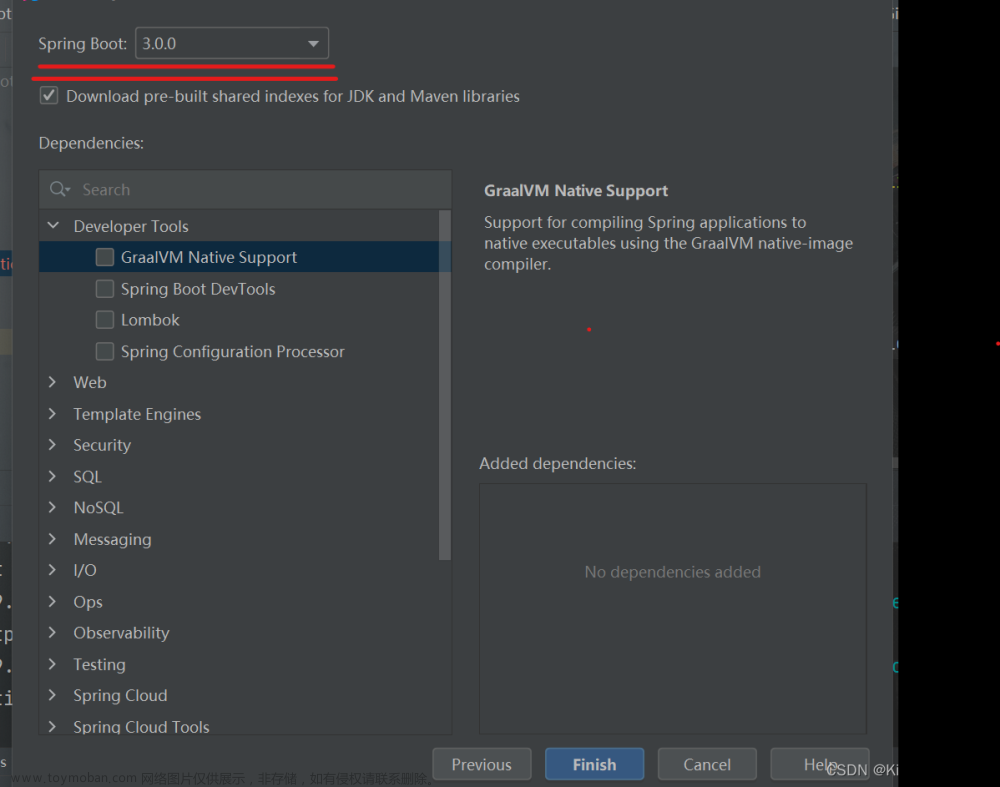序
本文主要研究一下springboot的启动事件
SpringApplicationEvent
org/springframework/boot/context/event/SpringApplicationEvent.java
public abstract class SpringApplicationEvent extends ApplicationEvent {
private final String[] args;
public SpringApplicationEvent(SpringApplication application, String[] args) {
super(application);
this.args = args;
}
public SpringApplication getSpringApplication() {
return (SpringApplication) getSource();
}
public final String[] getArgs() {
return this.args;
}
}
SpringApplicationEvent继承了ApplicationEvent,它有几个子类分表是ApplicationStartingEvent、ApplicationEnvironmentPreparedEvent、ApplicationContextInitializedEvent、ApplicationPreparedEvent、ApplicationStartedEvent、ApplicationReadyEvent,期间有异常则抛出ApplicationFailedEvent
SpringApplication.run
org/springframework/boot/SpringApplication.java
public ConfigurableApplicationContext run(String... args) {
StopWatch stopWatch = new StopWatch();
stopWatch.start();
ConfigurableApplicationContext context = null;
Collection<SpringBootExceptionReporter> exceptionReporters = new ArrayList<>();
configureHeadlessProperty();
SpringApplicationRunListeners listeners = getRunListeners(args);
listeners.starting();
try {
ApplicationArguments applicationArguments = new DefaultApplicationArguments(args);
ConfigurableEnvironment environment = prepareEnvironment(listeners, applicationArguments);
configureIgnoreBeanInfo(environment);
Banner printedBanner = printBanner(environment);
context = createApplicationContext();
exceptionReporters = getSpringFactoriesInstances(SpringBootExceptionReporter.class,
new Class[] { ConfigurableApplicationContext.class }, context);
prepareContext(context, environment, listeners, applicationArguments, printedBanner);
refreshContext(context);
afterRefresh(context, applicationArguments);
stopWatch.stop();
if (this.logStartupInfo) {
new StartupInfoLogger(this.mainApplicationClass).logStarted(getApplicationLog(), stopWatch);
}
listeners.started(context);
callRunners(context, applicationArguments);
}
catch (Throwable ex) {
handleRunFailure(context, ex, exceptionReporters, listeners);
throw new IllegalStateException(ex);
}
try {
listeners.running(context);
}
catch (Throwable ex) {
handleRunFailure(context, ex, exceptionReporters, null);
throw new IllegalStateException(ex);
}
return context;
}
SpringApplication的run方法,先触发listeners.starting(),然后执行了prepareEnvironment,之后createApplicationContext,再进行prepareContext和refreshContext,最后触发listeners.started(context),之后执行callRunners,最后触发listeners.running(context),如有异常则会执行handleRunFailure
prepareEnvironment
private ConfigurableEnvironment prepareEnvironment(SpringApplicationRunListeners listeners,
ApplicationArguments applicationArguments) {
// Create and configure the environment
ConfigurableEnvironment environment = getOrCreateEnvironment();
configureEnvironment(environment, applicationArguments.getSourceArgs());
ConfigurationPropertySources.attach(environment);
listeners.environmentPrepared(environment);
bindToSpringApplication(environment);
if (!this.isCustomEnvironment) {
environment = new EnvironmentConverter(getClassLoader()).convertEnvironmentIfNecessary(environment,
deduceEnvironmentClass());
}
ConfigurationPropertySources.attach(environment);
return environment;
}
prepareEnvironment会触发listeners.environmentPrepared(environment),即发布ApplicationEnvironmentPreparedEvent
prepareContext
private void prepareContext(ConfigurableApplicationContext context, ConfigurableEnvironment environment,
SpringApplicationRunListeners listeners, ApplicationArguments applicationArguments, Banner printedBanner) {
context.setEnvironment(environment);
postProcessApplicationContext(context);
applyInitializers(context);
listeners.contextPrepared(context);
if (this.logStartupInfo) {
logStartupInfo(context.getParent() == null);
logStartupProfileInfo(context);
}
// Add boot specific singleton beans
ConfigurableListableBeanFactory beanFactory = context.getBeanFactory();
beanFactory.registerSingleton("springApplicationArguments", applicationArguments);
if (printedBanner != null) {
beanFactory.registerSingleton("springBootBanner", printedBanner);
}
if (beanFactory instanceof DefaultListableBeanFactory) {
((DefaultListableBeanFactory) beanFactory)
.setAllowBeanDefinitionOverriding(this.allowBeanDefinitionOverriding);
}
if (this.lazyInitialization) {
context.addBeanFactoryPostProcessor(new LazyInitializationBeanFactoryPostProcessor());
}
// Load the sources
Set<Object> sources = getAllSources();
Assert.notEmpty(sources, "Sources must not be empty");
load(context, sources.toArray(new Object[0]));
listeners.contextLoaded(context);
}
prepareContext会触发listeners.contextPrepared(context),即发布ApplicationContextInitializedEvent,执行完成之后触发listeners.contextLoaded(context),即发布ApplicationPreparedEvent
refreshContext
private void refreshContext(ConfigurableApplicationContext context) {
refresh(context);
if (this.registerShutdownHook) {
try {
context.registerShutdownHook();
}
catch (AccessControlException ex) {
// Not allowed in some environments.
}
}
}
protected void refresh(ApplicationContext applicationContext) {
Assert.isInstanceOf(AbstractApplicationContext.class, applicationContext);
((AbstractApplicationContext) applicationContext).refresh();
}
refreshContext会执行refresh方法
org/springframework/context/support/AbstractApplicationContext.java
public void refresh() throws BeansException, IllegalStateException {
synchronized (this.startupShutdownMonitor) {
// Prepare this context for refreshing.
prepareRefresh();
// Tell the subclass to refresh the internal bean factory.
ConfigurableListableBeanFactory beanFactory = obtainFreshBeanFactory();
// Prepare the bean factory for use in this context.
prepareBeanFactory(beanFactory);
try {
// Allows post-processing of the bean factory in context subclasses.
postProcessBeanFactory(beanFactory);
// Invoke factory processors registered as beans in the context.
invokeBeanFactoryPostProcessors(beanFactory);
// Register bean processors that intercept bean creation.
registerBeanPostProcessors(beanFactory);
// Initialize message source for this context.
initMessageSource();
// Initialize event multicaster for this context.
initApplicationEventMulticaster();
// Initialize other special beans in specific context subclasses.
onRefresh();
// Check for listener beans and register them.
registerListeners();
// Instantiate all remaining (non-lazy-init) singletons.
finishBeanFactoryInitialization(beanFactory);
// Last step: publish corresponding event.
finishRefresh();
}
catch (BeansException ex) {
if (logger.isWarnEnabled()) {
logger.warn("Exception encountered during context initialization - " +
"cancelling refresh attempt: " + ex);
}
// Destroy already created singletons to avoid dangling resources.
destroyBeans();
// Reset 'active' flag.
cancelRefresh(ex);
// Propagate exception to caller.
throw ex;
}
finally {
// Reset common introspection caches in Spring's core, since we
// might not ever need metadata for singleton beans anymore...
resetCommonCaches();
}
}
}
refresh先执行postProcessBeanFactory,比如添加BeanPostProcessors,之后执行invokeBeanFactoryPostProcessors,即执行BeanFactoryPostProcessor的postProcessBeanFactory方法
refresh执行完之后触发listeners.started(context)即发布ApplicationStartedEvent
执行完callRunners之后触发listeners.running(context)即发布ApplicationReadyEvent
handleRunFailure
private void handleRunFailure(ConfigurableApplicationContext context, Throwable exception,
Collection<SpringBootExceptionReporter> exceptionReporters, SpringApplicationRunListeners listeners) {
try {
try {
handleExitCode(context, exception);
if (listeners != null) {
listeners.failed(context, exception);
}
}
finally {
reportFailure(exceptionReporters, exception);
if (context != null) {
context.close();
}
}
}
catch (Exception ex) {
logger.warn("Unable to close ApplicationContext", ex);
}
ReflectionUtils.rethrowRuntimeException(exception);
}
触发listeners.failed(context, exception)即发布ApplicationFailedEvent
小结
SpringApplication的run方法,先触发listeners.starting()(ApplicationStartingEvent),然后执行了prepareEnvironment(ApplicationEnvironmentPreparedEvent),之后createApplicationContext,再进行prepareContext和refreshContext(ApplicationContextInitializedEvent–>ApplicationPreparedEvent),最后触发listeners.started(context)(ApplicationStartedEvent),之后执行callRunners,最后触发listeners.running(context)(ApplicationReadyEvent),期间有异常会执行handleRunFailure,触发listeners.failed(context, exception)(ApplicationFailedEvent)文章来源:https://www.toymoban.com/news/detail-671415.html
其中refresh的时候会执行BeanFactoryPostProcessor的postProcessBeanFactory方法
整体顺序如下:ApplicationStartingEvent --> ApplicationEnvironmentPreparedEvent --> ApplicationContextInitializedEvent --> ApplicationPreparedEvent --> ApplicationStartedEvent --> ApplicationReadyEvent,期间有异常则抛出ApplicationFailedEvent文章来源地址https://www.toymoban.com/news/detail-671415.html
到了这里,关于聊聊springboot的启动事件的文章就介绍完了。如果您还想了解更多内容,请在右上角搜索TOY模板网以前的文章或继续浏览下面的相关文章,希望大家以后多多支持TOY模板网!










